Galleries
Palestinians and Arabs Hang Tough at the New Museum
Massimiliano Gioni opens up the Middle East as Tel Aviv and Gaza trade fire.
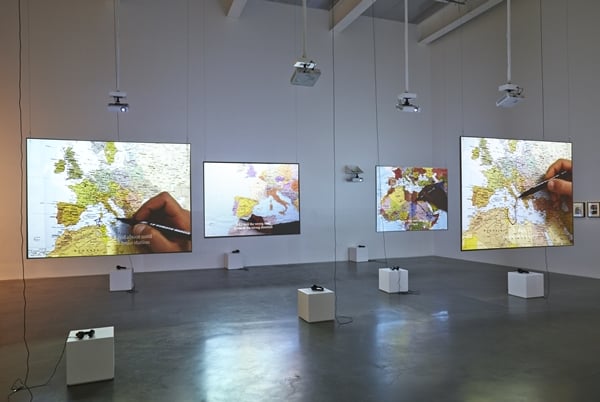
Massimiliano Gioni opens up the Middle East as Tel Aviv and Gaza trade fire.

Christian Viveros-Fauné

Early on in their contentious essay for the catalogue accompanying “Here and Elsewhere,” the New Museum’s sprawling, sometimes trying, yet illuminating exhibition of recent art from the Arab world, the show’s curators ask a remarkably timely question: “Is it possible to imagine a history of art that is completely divorced from cultural or social histories?”
The answer to that question—make that plural answers—is displayed throughout the New Museum’s five floors with varying measures of success in the form of didactic displays of critical, documentary and conventional artworks. Still, it’s no secret that this survey, New York’s first museum exhibition of art from the region, is long overdue. No matter the show’s drawbacks, experiencing it is like being introduced to a tribe of long lost colorful cousins, aunts and uncles. Even if you don’t get on with everyone, the takeaway is sympathetically simple: finally.
An exhibition that brings together 45 artists from 12 countries working in different media and from different cultural contexts, “Here and Elsewhere” makes a silk purse from the sow’s ear that is the “progressive” response to exhibitions with a geographical remit. A long-standing bias that rightly warns against essentialist approaches toward “alterity,” the art club’s knee-jerk reaction to regionally organized shows wrongly militates against shaking up New York’s toplofty provincialism (let’s face it, we no longer rate art here unless there’s money in it). Luckily, the New Museum’s curatorial team—led by recently promoted artistic director Massimiliano Gioni and curatorial associate Natalie Bell—decided to keep the baby and chuck the bathwater.The result is an exhibition that is radically regional in all sorts of ways, yet decidedly international and urgently networked in others.
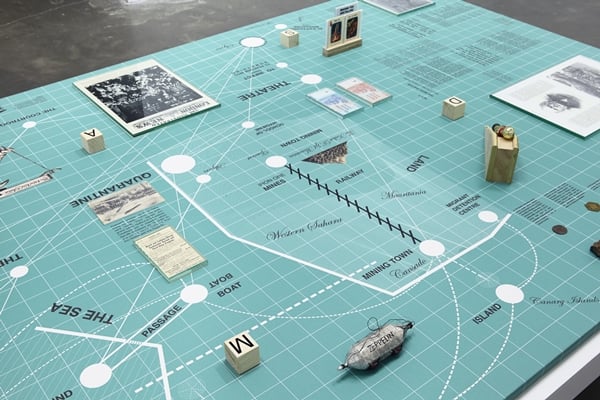
Installation view, “Here and Elsewhere.” Photo: Benoit Pailley, courtesy New Museum, New York.
Titled after a 1976 film by Jean-Luc Godard, Jeanne Pierre-Gorin, and Anne-Marie Miéville, “Here and Elsewhere” adopts a rambling Godardian approach to presenting the complexities of making and seeing art in the Arab world. These involve, among other curatorial and artistic minefields: the ethics of representation, the status and value of images as instruments of political consciousness, the legacies of various overlapping colonial and postcolonial histories, the real life effects of decades of violent authoritarianism, the recent upheavals brought about by the Arab Spring and the area’s civil wars, and, finally, the increasingly fluid position of the artist in the face of historical events. To paraphrase Philo of Athens: everyone everywhere is fighting a great battle, but artists hang extra tough in the Arab world.
Unlike the great majority of gallery-worthy objects in the West, nearly all the art on view in “Here and Elsewhere” takes on board at least some of these preoccupations. But the exhibition shares more than just a title with Godard et al. Highly anxious objects, installations, and moving and still images, the works featured in “Here and Elsewhere” reflect shifting contexts and largely refuse straight readings—traits reminiscent of movies from the 1960s New Wave. At times walking through the New Museum, with its more than 13 hours of film and video, can feel like an Islamic Cultural Center revival of the French Nouvelle Vague.
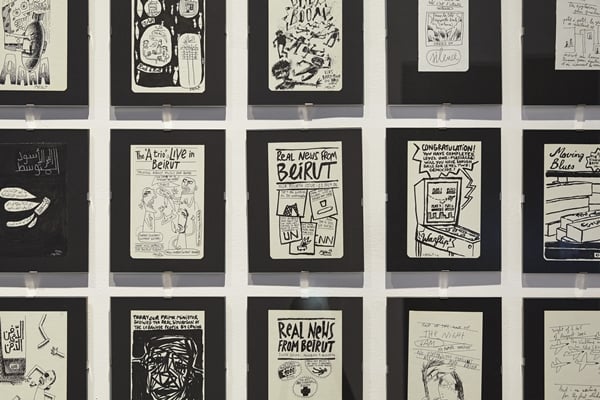
Installation view, “Here and Elsewhere.” Photo: Benoit Pailley, courtesy New Museum, New York.
Like many exhibitions of chronically unsung and undersung art, the highly heterogenous works in “Here and Elsewhere” can be divided into two general camps: intensely cogitative or high-octane gems, and the not ready for prime time. Unsurprisingly, many of the exhibition’s more conventional paintings and sculptures belong in the latter category, as befits an expressive but diffuse tradition short on art schools and similar institutions. On the other hand, the show’s many highlights rely overwhelmingly on the use of photographic or video cameras for their insights. There are the pictures of the Lebanese Fouad Elkoury, for instance, which document Beirutis sunbathing and posing for family portraits amid the bombed out ruins of “the Paris of the Middle East”; Harair Sarkissian’s forlorn images of empty Syrian town squares where public hangings once took place; and Tanya Habjouqa’s photos of what amount to digital-era lockets: cherished cell phone images of dead fathers, husbands, and brothers lost to Syria’s bloody uprising.
Studies in fateful incongruity, each of these works points up, with no shortage of poignancy or black humor, the yawning gulf between the promises made by the region’s competing national, political, religious, and ethnic interests, and the reality of living the examined life during wartime. This basic discordancy is further explored by Egyptian video artist Wael Shawky’s recitation of the Quran while strolling the aisles of a Dutch supermarket, but also by the hand-drawn travel logs of Bouchra Khalili. Eight map-based and narrated projections that trace the harrowing routes taken by millions of illegal migrants to Europe, these journeys also point to the less-rocky roads traveled by many of the region’s cultural elite. Khalili’s own life, for one, also relays the itinerant and worldly nature of Arab exile—she was born in Morocco, studied in Paris and lives and works in Berlin.
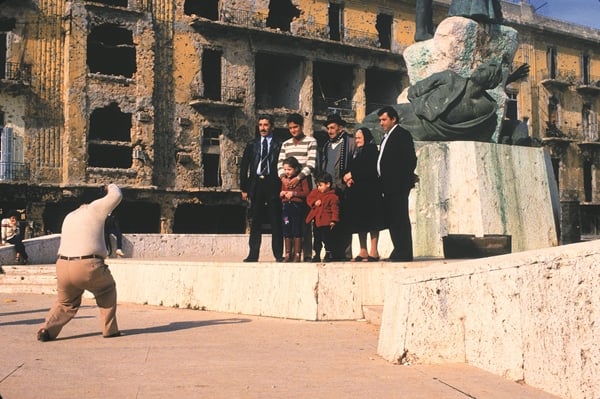
Fouad Elkoury, Place des Canons (Beirut 1982) (2014). Courtesy the artist, the Third Line, Dubai, and Galerie Tanit, Munich/Beirut.
Other artists in “Here and Elsewhere” defy normal artistic expectations and repeated attempts to classify their works as belonging to this or that camp. Among those are the Buffalo-born, Beirut-based Rheims Alkadhi, a maker of Gabriel Orozco–like ephemeral sculptures that, in one memorable instance, combine flea-market stuff like a back brace and rubber valves to make an alien armadillo; and Wafa Hourani, an installation artist whose ramshackle constructions propose shrewdly messaged, naïve-looking futures for Qalandia, an actual Palestinian refugee camp. But perhaps no one outpaces the easy assumptions attached to museum-ready contemporary fare more than the video shock jock Hiwa K. A kamikaze artist and political refugee, his 2011 hijacking of a violent political demonstration in his native Iraq by means of a guitar, a megaphone, a video camera and the theme song to Sergio Leone’s “Once Upon a Time In the West” is a study in crowd whispering that makes both for mesmerizing viewing and head-scratching conclusions. After watching the video—its title This Lemon Tastes of Apple hints at the citrus juice cure for tear gas, but not at the baton charges or live rounds that accompany the artist’s total immersion in unidentified repression—one naturally wants to ask: “Is this really art?” If this webpage could nod it would do so vigorously in the affirmative.
Whatever their gifts or shortcomings, the artists in “Here and Elsewhere” retain—thanks to their volatile geography and the West’s lack of curiosity—significant disadvantages when it comes to being embraced by the global art industry. But, they do have something our artistic capitals urgently lack. Critical thinkers who know that art is never, ever truly divorced from life’s triumphs and nightmares, they are artists of their time.
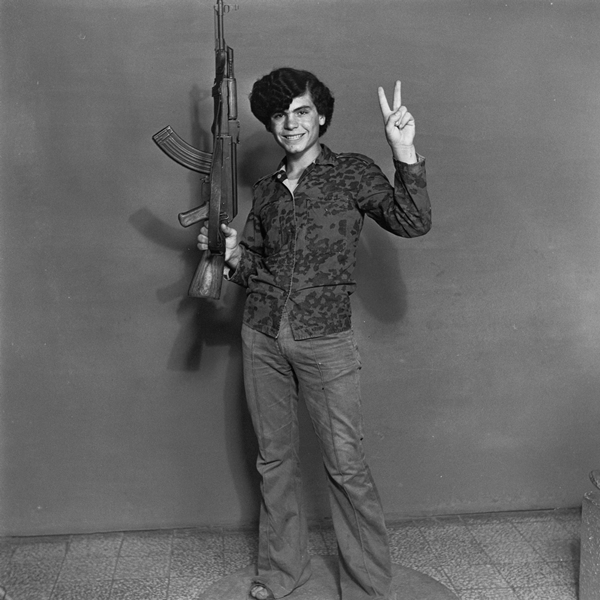
Akram Zaatari, Hashem El Madani—Palestinian resistant, Studio Shehrazade, Saïda, Lebanon, 1970–72. From “Objects of study/The archive of Shehrazade/Hashem el Madani/Studio practices,” 2006. Courtesy the artist and Sfeir-Semler Gallery, Beirut/Hamburg.
[Featured image: Yto Barrada, N du mot Nation en arabe, Tanger (N of the Nation in Arabic, Tangier) (2003). Courtesy the artist and Sfeir-Semler Gallery, Beirut/Hamburg.]